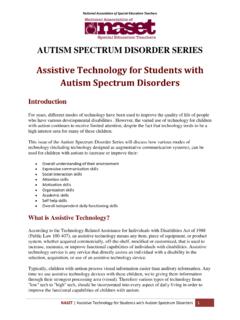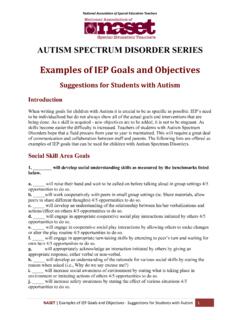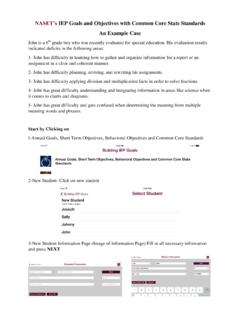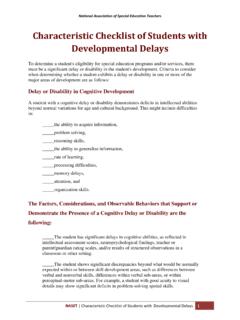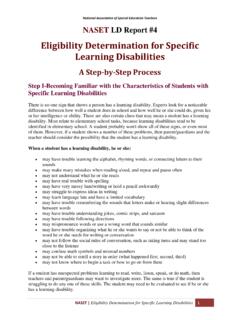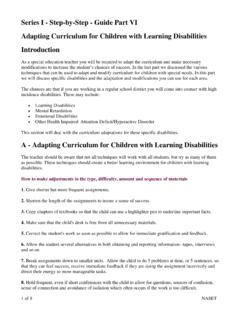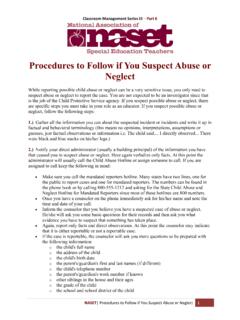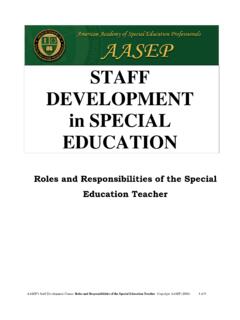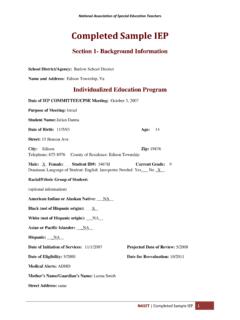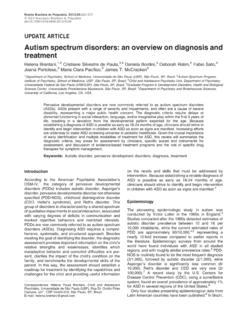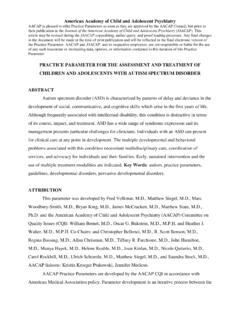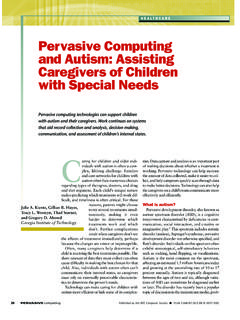Transcription of AUTISM SPECTRUM DISORDER SERIES - Special education
1 National Association of Special education Teachers AUTISM SPECTRUM DISORDER SERIES Types of AUTISM SPECTRUM disorders Autistic DISORDER (Classic AUTISM ) Autistic DISORDER (sometimes called classical AUTISM ) is the most common condition in a group of developmental disorders known as the AUTISM SPECTRUM disorders (ASD). Classic AUTISM is characterized by impaired social interaction, problems with verbal and nonverbal communication, and unusual, repetitive, or severely limited activities and interests (National Institute of Neurological disorders and Stroke, 2005a). There are three distinctive behaviors that characterize children with classic AUTISM . These children have difficulties with social interaction, problems with verbal and nonverbal communication, and repetitive behaviors or narrow, obsessive interests. The behaviors can range in impact from mild to disabling. Other common symptoms of classic AUTISM include (Westling & Fox, 2004; Deutsch-Smith, 2004; Heward, 2006; Gargiulio, 2004): Difficulty in expressing needs; uses gestures or pointing instead of words Difficulty in relating to and mixing in with others Does not respond to normal teaching methods Does not respond verbal cues Exhibits minimal or no eye contact Exhibits over sensitivity or under sensitivity to pain Exhibits physical over activity or extreme under activity Has difficulty expressing and receiving physical affection Has no real fears of danger Maintains inappropriate attachments to objects Motor skills are uneven Often exhibits tantrums Prefers to be alone.
2 Aloof manner Repetition of words or phrases in place of normal, responsive language Resistance to change Spins objects Sustained odd play According to the AUTISM Society of America (2005), there is no known single cause for autistic DISORDER , but it is generally accepted that it is caused by abnormalities in brain structure or function. Brain scans show differences in the shape and structure of the brain in autistic versus non-autistic children. NASET |Types of AUTISM SPECTRUM disorders 1 National Association of Special education Teachers Researchers are investigating a number of theories, including the link between heredity, genetics and medical problems. In many families, there appears to be a pattern of AUTISM or related disabilities, further supporting a genetic basis to the DISORDER (National Institute of Neurological disorders and Stroke, 2005a). While no one gene has been identified as causing AUTISM , researchers are searching for irregular segments of genetic code that autistic children may have inherited.
3 It also appears that some children are born with a susceptibility to AUTISM , but researchers have not yet identified a single "trigger" that causes AUTISM to develop. Childhood Disintegrative DISORDER Childhood disintegrative DISORDER is a condition occurring in 3- and 4-year-olds who have developed normally to age 2. Over several months, a child with this DISORDER will deteriorate in intellectual, social, and language functioning from previously normal behavior ( National Library of Medicine 2004b). Childhood disintegrative DISORDER develops in children who have previously seemed perfectly normal. Typically language, interest in the social environment, and often toileting and self-care abilities are lost, and there may be a general loss of interest in the environment. The child usually comes to look very 'autistic', , the clinical presentation (but not the history) is then typical of a child with ASD (Yale Developmental Disabilities Clinic, 2006).
4 An affected child shows a loss of communication skills, has regression in nonverbal behaviors, and significant loss of previously-acquired skills. The condition is very similar to classic AUTISM . Symptoms of Childhood Disintegrative DISORDER may include ( National Library of Medicine 2004b): Loss of social skills Loss of bowel and bladder control Loss of expressive or receptive language Loss of motor skills Lack of play Failure to develop peer relationships Impairment in nonverbal behaviors Delay or lack of spoken language Inability to start or sustain a conversation Childhood Disintegrative DISORDER must be differentiated from both childhood schizophrenia and pervasive developmental DISORDER (PDD). The most important signs of childhood disintegrative DISORDER are loss of developmental milestones ( National Library of Medicine, 2004b). The child tends to have normal development through age 3 to 4 and then over a few months undergoes a gradual loss of previously established abilities listed above in Diagnostic Symptoms ( , language, motor, or social skills).
5 The cause is unknown, but it has been linked to neurological problems (Yale Developmental Disabilities Clinic, 2006). NASET |Types of AUTISM SPECTRUM disorders 2 National Association of Special education Teachers Rett Syndrome Rett Syndrome (RS) is a neurological DISORDER seen almost exclusively in females, and found in a variety of racial and ethnic groups worldwide (International Rett Syndrome Association, 2005). An inability to perform motor functions is perhaps the most severely disabling feature of Rett syndrome, interfering with every body movement, including eye gaze and speech. Other diagnostic symptoms of Rett Syndrome include (International Rett Syndrome Association, 2005; National Institute on Neurological disorders and Stroke, 2005c): An early period of apparently normal or near normal development until 6 18 months of life. A period of temporary stagnation or regression follows during which the child loses communication skills and purposeful use of the hands.
6 Stereotyped hand movements gait disturbances slowing of the rate of head growth become apparent Seizures Disorganized breathing patterns which occur when awake Compulsive hand movements such as wringing and washing follow the loss of functional use of the hands pervasive Developmental DISORDER , Not Otherwise Specified (PDD-NOS) pervasive Developmental DISORDER , Not Otherwise Specified (PDD-NOS) is a developmental-neurologic SPECTRUM DISORDER , occurs in 10 to 12 of every 10,000 children. Children with PDD-NOS either (a) do not fully meet the criteria of symptoms clinicians use to diagnose any of the four specific types of PDD above, and/or (b) do not have the degree of impairment described in any of the above four PDD specific types. PDD-NOS will present similarly to the kids who have ASD (some people argue that these conditions should be combined as one), but will have a lesser degree of a severe impairment.
7 These kids are more likely to be verbal and have some degree of verbal or non-verbal effective communication, yet they must have the autistic features and a severe impairment in social interaction, communication, or repetitive stereotype behavior. This term is reserved for children with a severe impairment who do not fully qualify for any other autistic diagnosis, due to age of onset or combination of autistic features. Asperger Syndrome In Asperger syndrome, a young child experiences impaired social interactions and develops limited repetitive patterns of behavior (Nemours Foundation, 2005). Motor milestones may be delayed and clumsiness is often observed ( National Library of Medicine, 2004a). However, people with Asperger syndrome usually have fewer problems with language than those with ASD, often speaking fluently, though their words can sometimes sound formal or stilted. People with Asperger syndrome do not usually have the accompanying learning disabilities associated with ASD; in fact, people with Asperger syndrome are often of average or above average intelligence (National Autistic Society, 2005).
8 School-age children with Asperger syndrome exhibit a range of characteristics, with varying degrees of severity. Diagnostic Symptoms of Asperger DISORDER includes (Hallahan & Kauffman, 2006; Turnbull, Turnbull, & Wehmeyer, 2006; Friend, 2005; Westling & Fox, 2004; NASET |Types of AUTISM SPECTRUM disorders 3 National Association of Special education Teachers s of AUTISM SPECTRUM disorders NASET |Type4 National Institute of Neurological disorders and Stroke, 2005a; National Library of Medicine, 2004a; Mayo Clinic, 2004): Social skills Has difficulty making friends Engages in one sided, long winded conversations, without noticing if the listener is listening or trying to change the subject Displays unusual nonverbal communication, such as lack of eye contact, few facial expressions, or awkward body postures and gestures Doesn't empathize with or seem sensitive to others' feelings and has a hard time "reading" other people or understanding humor Doesn't understand the give and take of conversation or engage in "small talk" Seems egocentric or self absorbed May speak in a voice that is monotone, rigid, jerky or unusually fast Can be extremely literal or have difficulty understanding the nuances of language, despite having a good vocabulary Behavior Shows an intense obsession with one or two specific, narrow subjects, such as baseball statistics, train schedules.
9 Weather or snakes Likes repetitive routines or rituals May memorize information and facts easily, especially information related to a topic of interest May have clumsy, uncoordinated movements, an odd posture or a rigid gait May perform repetitive movements, such as hand or finger flapping May engage in violent outbursts, self injurious behaviors, tantrums or meltdowns May be hypersensitive to sensory stimulation, such as light, sound and texture Asperger Syndrome is a neurobiological DISORDER named for a Viennese physician, Hans Asperger, who in 1944 published a paper which described a pattern of behaviors in several young boys who had normal intelligence and language development, but who also exhibited autistic-like behaviors and marked deficiencies in social and communication skills (National Institute of Neurological disorders and Stroke, 2005a). Overall, people with AS are quite capable of functioning in everyday life, but they tend to be somewhat socially immature and may be seen by others as odd or eccentric (Nemours Foundation, 2005).
10 They have higher intelligence and communication skills than those with classic or more severe forms of ASD, but they display most, if not all of the other characteristics of ASD, with their primary difficulties manifested in poor social interactions (Hallahan & Kauffman, 2006).
